SAARC focus partnership for our people
With great expectations for a thriving future:
By Dhaneshi Yatawara
[email protected]

President Mahinda Rajapaksa extends a warm welcome to Indian
Prime Minister Dr. Manmohan Singh at the Presidential
Secretariat |
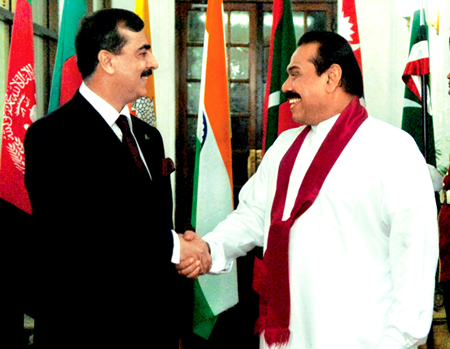
Prime Minister of Pakistan Yosuf Raza Gilani warmly greeted by
President Rajapaksa on arrival. |
With the hope of creating an effective partnership among the member
countries of the South Asian region was the great expectation that
prompted the formation of our own South Asian Association of Regional
Cooperation (SAARC), back in the 1980s.
The SAARC was established when its Charter was formally adopted on 8
December 1985 by the heads of state of the Governments of Bangladesh,
Bhutan, India, Maldives, Nepal, Pakistan and Sri Lanka. Afghanistan was
joined the groups at the behest of India on November 13, 2005 and became
a member on April 3, 2007.
Terrorism, with food security and energy have been listed as a major
discussing points at the current Summit held in Colombo.
Better partnership
The Summit, as we expect, will dwell exhaustively on strengthening
opportunities of interactions for the sake of overcoming any
misconception among the public at large.
Sri Lanka’s Foreign Ministry spokesman Prasad Kariyawasam told the
media last week that SAARC will transform from its declaratory status
into an implementation status with this year’s theme “The SAARC:
Partnership for our people”.
A number of issues, including the SAARC Fund, regional food and
energy security and combating terrorism at the regional level is under
focus in this summit at various levels.

President of Afghanistan Hamid Karzai with President Rajapaksa |
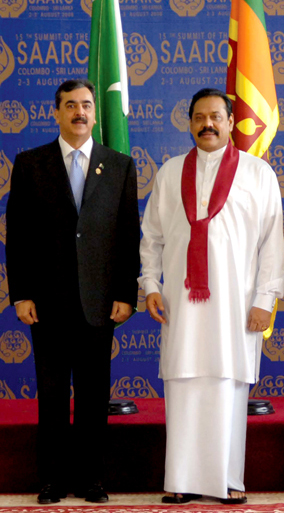
Prime Minister of Pakistan Yosuf Raza Gilani with President
Rajapaksa |
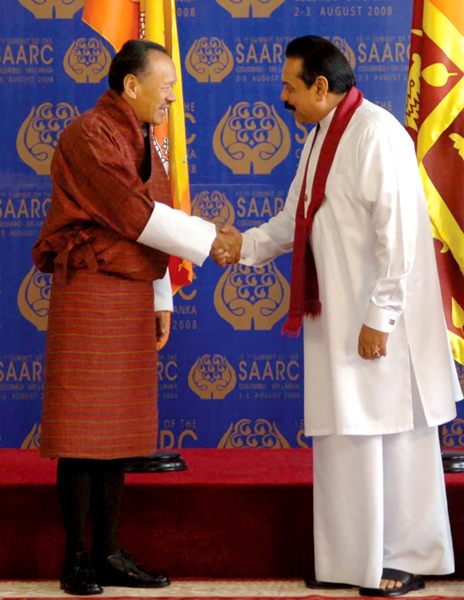 |
 |
|
Bhutan Prime Minister Lyonpo Jigmi Y Thinley greeted by
President Rajapksa |
Head of State and Chief Advisor of Bangladesh Dr. Fakhruddin
Ahmed with President Rajapaksa |
The Colombo Declaration of food security is hoped to be formalised at
the end of the Summit. The question of modern agriculture and effective
use of non-farm sector might emerge for consideration.
The Standing Committee meeting was held with the foreign secretaries
of the eight member countries focusing on issues relating to regional
food and energy security and collectively combating terrorism.
These efforts will obviously ensure opportunities to augment the
areas of co-operation, but use of solar power and hydro-electricity to
meet the growing demand of power shall be more useful at this stage. The
establishment of a Regional Food Bank shall help to overcome the
emerging problems of the member states.
For a better SAARC
Sri Lanka has an important role in South Asian cooperation as we have
a better relationship with other SAARC nations that could be a positive
influence in the decision making process of SAARC.
For a better SAARC, all member countries should consider the pattern
and extent of relationship among nations taking in to serious
consideration the internal socio-political environment for building of a
common goal for the region. This gathering of South Asian Heads of the
States/Governments is very important because of the volatile situation
running throughout the region.
The principal task that the leaders of states should prioritize is
the global, regional and bilateral issues and challenges which should be
overcome through a combined initiative and method.
The experience of the SAARC Co-operative Council might play a major
role in ensuring sustainable economy in the rural areas. Equally, the
SAARC Quadrangle Milk Grid should be made functional to help the white
revolution in member countries.
There could be total commitment on certain issues as provided in the
Social Charter signed in 2004 in Pakistan. Article III of the Social
Charter on poverty alleviation, Article IV on Health, Article V on
education and human resource development, are important to ensure
people’s partnership in the right spirit.
Promote economic, social and cultural development of our peoples and
to improve the quality of their lives; collaboration in economic,
social, cultural technical and scientific fields; mutual trust and
understanding among the peoples of South Asia; collaboration among
themselves in international forums in matters of common interest and
strengthen collective self reliance among the countries of South Asia
were the principal objectives SAARC countries set for themselves.
Seven Technical Committees were also established in terms of the work
involved with regard to the ‘Integrated Programme of Action,’ which was
launched at the first meeting of the foreign ministers, which was held
in Delhi in 1983. It was also decided to establish the following
Regional Centres, with each such centre to be managed by a governing
board;
1. Regional Agricultural Information Centre
2. Documentation Centre
3. Human Resources Development Centre
4. Tuberculosis Prevention Centre
5. Meteorological Research Centre.
The institutional set-up established is comprehensive in terms of
achieving the goals the leaders had set for our countries. The highest
authority of the association would rest with the heads of state. The
Council of Ministers would be responsible for the formulation of
policies, reviewing progress and deciding on new areas of progress. The
Council was expected to meet twice a year.
The Standing Committee, comprising foreign secretaries of the member
states, the present committee chaired by Sri Lanka Foreign Secretary Dr.
Palitha Kohona is another significantly important set up in the total
SAARC structure. Their responsibility was to monitor and coordinate
programmes. It was to meet as often as was deemed necessary and to
report to the Council of Ministers.
An all important committee for regional economic cooperation was
established from which emerged the SAARC Preferential Trade initiative,
or the SAPTA. This Committee on Economic Cooperation was to comprise of
the secretaries of commerce and trade of the member states to strengthen
and enhance inter-governmental cooperation in the fields of trade and
economic relations.
The SAPTA framework agreement was signed at the Dhaka Summit and came
into operation in 1983. Following the SAPTA it was decided at the 10th
Summit in Colombo in 1998 to set up a committee to draft a comprehensive
treaty to create a free trade area within the region.
It is noteworthy to mention some of the other similar valuable
initiatives such as steps taken to support the enhancement of the
financial systems of SAARC countries through building institutional
capacity and the need to establish a network of researchers on global,
financial and economic issues and developments, to help analyse and
assist member states of SAARC to face global financial and economic
developments along with the Social Charter and the Poverty Alleviation
project.
The SAARC Social Charter highlights securing of the rights of women
and children as the foremost consideration and has received the highest
priority.
Poverty alleviation
The other important SAARC initiative was the elimination of poverty
established at the sixth SAARC Summit in Colombo in 1991. It had been
decided to set up an independent South Asia Commission on Poverty
Alleviation.
The Summit meetings that followed welcomed the initiative and
expressed their commitment to eradicate poverty in South Asia through an
agenda of action which would include a strategy for social mobilization,
a policy of decentralized agricultural development, village awakening,
small-scale labour intensive industrialisation and human development.
SAARC has come a long way yet it has walk miles further to bring in a
prosperous South Asia. Its inability to play a crucial role in
integrating South Asia is often credited to the inter and intra
political and military rivalries.
It is due to these economic, political, and territorial disputes that
South Asian nations have not been able to harness the benefits of a
unified economy. Building of a social safety net for the people of South
Asia is the goal, and should be the principal goal, for SAARC leaders.
If they could be able to make it possible, the upcoming SAARC Summit
might be a remarkable one.
 |
| President Mahinda
Rajapaksa and Indian Prime Minister Dr. Manmohan Singh
flanked by First Lady Shiranthi Rajapaksa and Madam Singh. |
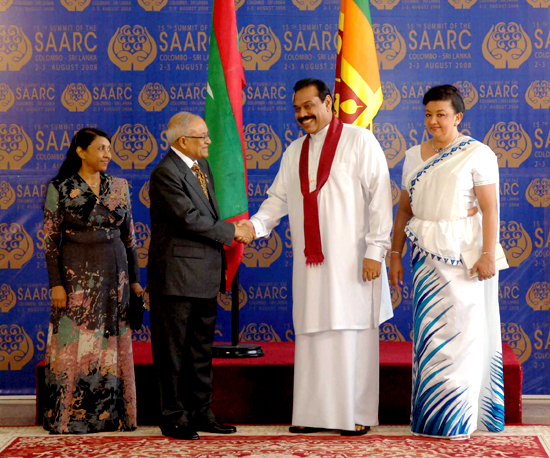 |
| President of Maldives
Maumoon Abdul Gayoom and Madam Gayoom with President
Rajapaksa and the First Lady. |
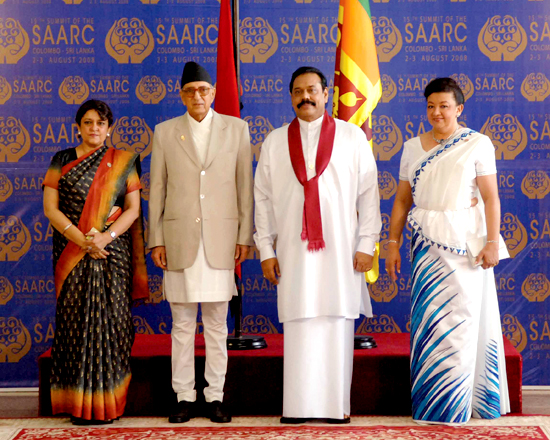 |
| Nepal’s Prime
Minister, Girija Prasad Koirala and Madam Koirala with
President Rajapaksa and the First Lady. |
|
